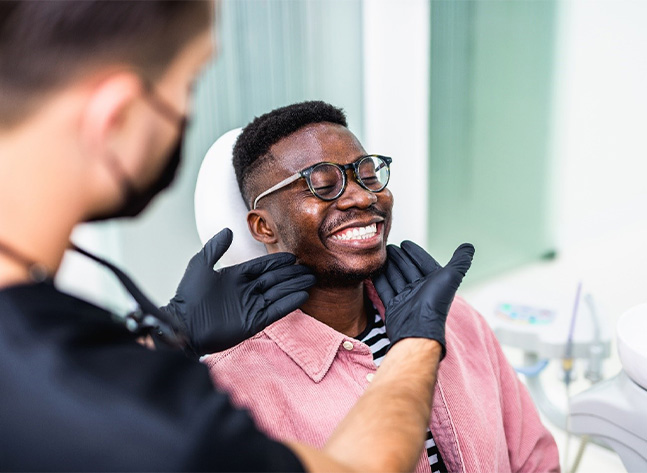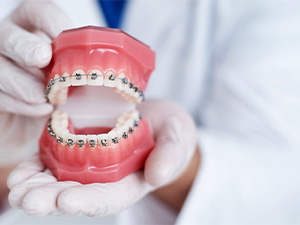Traditional Braces – Oklahoma City, OK
A Reliable Solution for Straighter Teeth

For decades, patients have turned to traditional braces to close gaps, fix overcrowding, and realign overbites. Using a common bracket-and-wire system, these reliable orthodontic appliances stand the test of time. Here at Casady Square Orthodontics, we will examine your smile to determine if the problems you’re experiencing are best suited for metal braces. To learn if you are a perfect fit for traditional braces in Oklahoma City, contact us today.
Why Choose Casady Square Orthodontics for Traditional Braces?
- All Ages Welcome
- Dental Insurance Welcome
- Evening Appointments Available
How Do Traditional Braces Work?

Traditional braces rely on a standard bracket-and-wire system. Using continual pressure to move teeth into alignment, gaps close, space is added to crowded teeth, and bites shift into proper formation for greater functionality.
Dr. Ishani cements the metal brackets to each tooth before threading a uniquely bent wire that is held into place by the brackets. Throughout treatment, he will need to adjust and tighten the wire to keep teeth moving in the right direction; however, once everything is fully aligned and in place, you can expect to see a new and improved smile.
Benefits of Traditional Braces

When opting to pursue traditional braces to straighten your smile, you will find many benefits come with this type of orthodontic treatment, some of which include:
- Greater versatility when treating a wide array of dental problems
- Typically, much less expensive than other orthodontic solutions
- Customizable with regard to rubber bands, brackets, and wires
- Ability to better conceal treatment with tooth-colored brackets and wires
Tips for Life with Traditional Braces

Life with traditional braces doesn’t have to be a hard one; however, you will need to make some adjustments while undergoing treatment. You’ll need to:
- Start brushing after every meal and floss at least once a day
- Cut up crunchy or hard foods to make it easier on your teeth and braces
- Consider the type of snacks you choose, as nuts, popcorn, and sticky candy can potentially damage your braces
- Wear a mouthguard if you play sports to avoid serious harm or injury
- Keep your regular follow-up appointments with your orthodontist in Oklahoma City
Understanding the Cost of Traditional Braces

Are you interested in getting braces, but want to learn more about the cost before committing? Good news: we can help! Our team at Casady Square Orthodontics will provide you with an estimate of the price during your consultation as well as review the financial solutions we offer. Of course, if you want to learn more on the topic before then, you can also keep reading.
Factors That Affect the Cost of Traditional Braces

There are general orthodontic issues, like overcrowding or spaced-out teeth. However, each patient’s smile is truly unique, which is why we need to consider multiple factors to give an accurate estimate of the cost of traditional braces. A few examples include:
- How severe your misalignment is.
- If you need to straighten one or both arches of teeth.
- If rubber bands, space maintainers, or any other orthodontic accessories are needed.
Of course, there are other factors that will impact the price. One example is the type of retainer you choose at the end of your treatment. Don’t worry – we will always do our best to be transparent about the cost so you know exactly what to expect every step of the way.
Professional Braces vs. "DIY" Braces: Which Costs More?

“DIY” braces are almost always cheaper. With that said, they aren’t better. In fact, many patients who have chosen this teeth-straightening route have horror stories, like having their teeth fall out. That’s why it’s always better to choose professional orthodontic treatments. Although they come with a higher upfront investment, they include thorough exams, detailed impressions, custom treatment plans, and supervision from a licensed orthodontist.
Does Dental Insurance Cover Braces?

Sometimes! There are dental insurance providers who offer a once-in-a-lifetime orthodontic benefit that can be used to cover a portion of the cost of traditional braces. If you want to double-check the fine print on your plan, you can call your provider directly or ask our team for help! We’re in-network with numerous PPO plans, and we can handle filing the claim for you so it’s even less of a headache. Simply put, we’re here to help you utilize your benefits to the fullest.
Options for Making Braces Affordable

But what if you don’t have dental insurance? Does that mean you have to pay for the entire cost of your treatment in one lump sum? Fortunately, the answer is “no.” With CareCredit, you can choose a payment plan that fits your monthly budget seamlessly. Plus, we offer complimentary consultations, which helps lower your out-of-pocket expenses as well. If you have any questions about the financial solutions we offer, don’t hesitate to get in touch with us!
Traditional Braces FAQs
Why Do My Teeth Feel Loose with Braces?
Throughout your teeth-straightening journey, your teeth may temporarily feel slightly loose. Not only is this completely normal, but it’s a good sign because your teeth are moving! Of course, the keyword is “slightly.” If one or more of your teeth feel like they are on the brink of falling out, then you should contact us right away so we can complete an exam.
Am I Too Old to Get Braces?
Since many patients undergo orthodontic treatment before the age of 18, many patients in their 30s, 40s, 50s, and 60s are left wondering if the ship has sailed for them on straight teeth. Luckily, the answer is no! After all, candidacy for braces isn’t determined by your age; it’s determined by the complexity of your case and other important factors. In short, if you are interested in exploring the orthodontic treatments available, schedule an appointment with us – we’d love to help!
Can I Get Traditional Braces on Just My Top or Bottom Teeth?
Since straightening one row of teeth and not the other can negatively impact your bite, it’s not usually recommended. Of course, there are some rare cases where single-arch treatment is possible. Once we take X-rays, conduct an exam, and have a better understanding of the complexity of your case, we’ll be able to determine if you can get traditional braces on just your top or bottom teeth.
Do Traditional Braces Hurt?
It’s very common for patients to be concerned about whether braces will hurt. We won’t lie to you; you can expect to feel some soreness from time to time as your teeth inch closer and closer to their ideal positions. With that said, this sensation will lessen as you progress through your treatment plan. Plus, there are several ways you can alleviate any discomfort that does arise, like using dental wax to cover your brackets and wires, sticking to soft foods like oatmeal, and taking OTC pain medication (as directed on the label).
What Can You Not Eat with Traditional Braces?
Sadly, there are some foods that you cannot eat with braces, including popcorn, whole apples, tortilla chips, hard pretzels, and raw nuts. That’s because crunchy, hard, and sticky foods can result in an orthodontic emergency, like a broken wire or loose bracket. So, it’s best to stick to foods like oatmeal, plain yogurt, vegetable soup, and scrambled eggs.
What Happens After You Get Your Braces Off?
After we take your braces off, we’ll take “after” pictures of your teeth so you can see the progress (which is always very exciting). We’ll also give you your retainer and give you specific instructions on how often to wear it. This is crucial because your teeth will naturally want to revert back to their original positions. This is a phenomenon known as “orthodontic relapse,” and wearing your retainer as instructed is one of the best ways to prevent that from happening.
